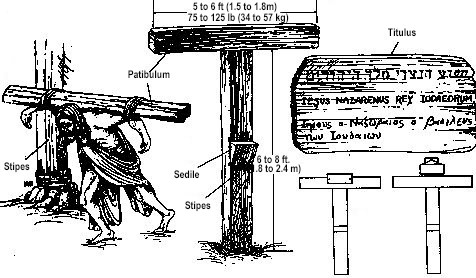 |
|
| Cross and titulus.
Left, Victim carrying crossbar (patibulum) to site of upright post (stipes).
Center, Low Tau cross (crux commissa), commonly used by Romans at time of Christ.
Upper right, Rendition of Jesus' titulus, with name and crime--Jesus of Nazareth,
King of the Jews--written in Hebrew, Latin, and Greek. Lower right, Possible
methods for attaching titulus to Tau cross (left) and latin cross (right).
|
|
Scourging of Jesus
At the
Praetorium, Jesus was severely whipped. (Although
the severity of the scourging is not discussed in
the four gospel accounts, it is implied in one of
the epistles (1 Peter 2:24). A detailed word
study of the ancient Greek text for this verse
indicates that the scourging of Jesus was
particularly harsh. (33) ) It is not known
whether the number of lashes was limited to 39,
in accordance with Jewish law. (5) The Roman
soldiers, amused that this weakened man had
claimed to be a king, began to mock him by
placing a robe on his shoulders, a crown of
thorns on his head, and a wooden staff as a
scepter in his right hand. (1) Next, they spat on
Jesus and struck him on the head with the wooden
staff. (1) Moreover, when the soldiers tore the
robe from Jesus' back, they probably reopened the
scourging wounds. (7)
The severe scourging, with its intense pain
and appreciable blood loss, most probably left
Jesus in a preshock state. Moreover, hematidrosis
had rendered his skin particularly tender. The
physical and mental abuse meted out by the Jews
and the Romans, as well as the lack of food,
water, and sleep, also contributed to his
generally weakened state. Therefore, even before
the actual crucifixion, Jesus' physical condition
was at least serious and possibly critical.
CRUCIFIXION Crucifixion probably first began among the
Persians. (34) |
Alexander the Great introduced the
practice to Egypt and Carthage, and the Romans
appear to have learned of it from the
Carthaginans. (11) Although the Romans did not
invent crucifixion, they perfected it as a form
of torture and capital punishment that was
designed to produce a slow death with maximum
pain and suffering. (10,17) It was one of the
most disgraceful and cruel methods of execution
and usually was reserved only for slaves,
foreigners, revolutionaries, and the vilest of
criminals. (3,25,28) Roman law usually protected
Roman citizens from crucifixion, (5) except
perhaps in the case of desertion by soldiers.
In its earliest form in Persia, the victim was either tied to a tree or was tied to or impaled on an upright post, usually to keep the guilty victim's feet from touching holy ground. (3,11,30,34,38). Only later was a true cross used; it was characterized by an upright post (stipes) and a horizontal crossbar (patibulum), and it had several variations (11). Although archaeological and historical evidence strongly indicates that the low Tau cross was preferred by the Romans in Palestine at the time of Christ, (2,7,11) crucifixion practices often varied in a given geographic region and in accordance with the imagination of the executioners, and the Latin cross and other forms also may have been used. (26) It was customary for the condemned man to carry his own cross from the flogging post to the site of crucifixion outside the city walls. (8,11,30) |
| Back | Next |